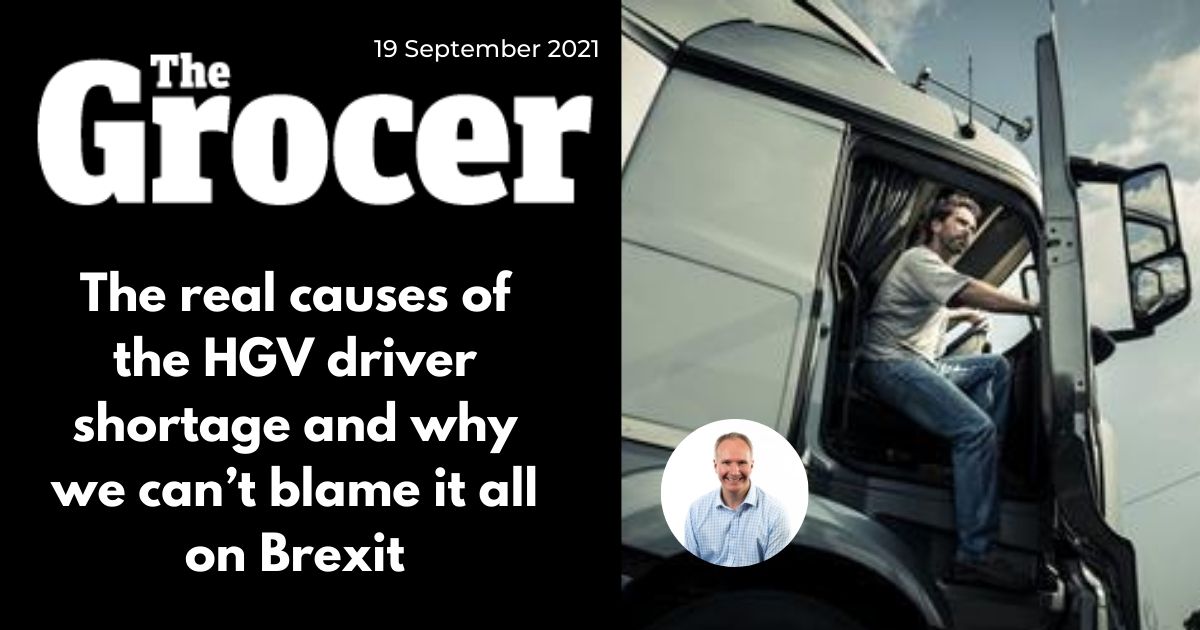The real causes of the HGV driver shortage and why we can’t blame it all on Brexit
Kieran Smith, CEO interviewed for The Grocer

The HGV driver shortage has escalated to crisis point. As multiple theories circulate over the underlying cause, The Grocer has sourced exclusive data to uncover what’s really driving the issue
What was once a quiet storm in the supply chain has escalated into a fully-fledged hurricane. The low-level shortage of HGV drivers – an issue that has long plagued haulage and logistics professionals – is now sizeable, acute, and urgent. It’s plaguing businesses of all shapes and sizes and leaving food shelves empty across the country.
While everyone involved has their take on the causes and the solutions, there has been a notable lack of evidence to support any particular claim. The result has been a growing rift between camps, most tellingly between industry and government.
But now with exclusive data, The Grocer is able to tell a fuller story, showing both the real causes behind the driver shortage as well as plotting a possible route out.
First and foremost, Britain’s driver shortage is not a new phenomenon. Even in the heady days before Covid or Brexit, the UK was already lacking around 76,000 drivers, according to Logistics UK.
The workforce has been increasingly stretched over recent years. While demand grew, the total number of drivers has remained fairly steady at around 300,000, according to ONS figures. The only significant growth has been among EU drivers, whose numbers surged from 10,000 in 2010 to 45,000 in 2017.
“Even in the heady days before Covid or Brexit, the UK was lacking 76,000 HGV drivers”
It means European drivers have become a vital part of the industry, topping up numbers and providing elasticity at times of increased demand. But this reliance on overseas labour has long been a source of concern. In July 2016, MPs urged the transport industry to “reduce dependence on foreign drivers”, stating “the principal responsibility… lies with the industry”.
The situation came to a head in the pandemic following a mass exodus of drivers from the UK workforce. Exclusive ONS data shows total numbers fell from around 304,000 in Q1 2020 to 235,000 in Q2 2021, representing a net loss of 69,000. Logistics UK estimates we are now approximately 90,000 drivers short of where we need to be.
So where have they all gone? And what can be done to bring them back?
For food and logistics industries, the loss of EU drivers is a primary factor in the shortage. In a recent letter to PM Boris Johnson, over 20 trade bodies and businesses urged the government to take action based on what they saw as the five key causes of the driver crisis.
These included post-Brexit immigration changes, which removed the rights of many EU drivers to live and work in the UK, and Covid-19, which led some drivers to return to their home countries from where many have opted not to return.
For these reasons, industry has pressed government for a temporary worker visa for HGV drivers to allow EU drivers to come back to the UK.
Unfortunately however, many of these drivers do not want to work in the UK even if they could. Not only has Brexit created endless paperwork and customs procedures , but working conditions are arguably superior in France, Germany and Belgium through such laws that make it illegal to work on Sundays.
This reluctance was voiced by dozens of drivers in the Financial Times last week. “I will never go back. I like England, it’s a great country. But to work, the way they treat people? Never again,” said one.
Plus, according to ONS data, the loss of EU drivers is only a minor cause of the shortage. At the start of 2020, before the pandemic hit, there were 37,000 EU drivers in the UK. Now, there are 24,500.
That loss of 12,500 drivers only goes a little way to explaining the current shortfall. Given a total of almost 70,000 drivers have left during the pandemic alone, this represents just 18% of those who have exited the HGV industry.
It led a logistics thinktank led by Driver Require to conclude “EU drivers leaving the UK did not significantly contribute to the current shortage”, in a new report published this week.
Brits are certainly the more significant factor. Over 55,000 domestic drivers left the industry during the pandemic. Retirement, a lack of driving tests during Covid, and tax changes have all been cited as the cause.
Retirement has certainly played its part. The haulage industry is an ageing workforce, evidenced by an average age of HGV drivers of 55 years old. Less than 1% are under 25, according to the Road Haulage Association. In 2019, the number of drivers over 50 exceeded those under 50 for the first time [ONS].
It means the rate of retirement has unsurprisingly risen over the past decade, from around 7,500 per year in 2010 to 10,000 per year in 2020, according to analysis of ONS data by Driver Require. This works out at about 4% of the workforce retiring each year.
In pre-pandemic times at least, this was more than offset by new entrants to the industry. Between 2015 and 2019, there were three times more test passes each year than retirements. In theory, driver numbers should have been growing.
However, this wasn’t the case – suggesting many of those who passed their test choose not to drive commercial HGV vehicles at all.
There are now more than 230,000 HGV licence holders under the age of 45 alone in the UK deciding not to work in the commercial haulage sector. For whatever reason, these people have spent around £3,000 acquiring an HGV license only to later opt out of driving commercial vehicles for a living.
To put that in perspective, there are more 30 to 34-year-olds that fall into this category than there were total EU drivers in the UK before the pandemic.
It is unclear exactly why the numbers are so high, although working conditions, salary rates, and unsociable hours are all thought to be factors in the exodus of qualified people from the industry.
Many individuals also hold an HGV licence for use in other roles such as driving distribution vans for the likes of Amazon and Ocado, while others will have moved into managerial roles. Some drivers will inevitably have stopped working altogether.
Alex Veitch, general manager of public policy at Logistics UK, says it is “imperative” government and industry listens to those who have left a career in HGV driving and acts accordingly.
“Poor facilities such as safe, secure rest places are a key issue for many of these drivers,” he says, although recent hikes to pay rates, bonuses and training schemes could also bring people back.
This could be something of a short-term fix: all these drivers need is a renewed CDC license, which requires just a one-week course.
For much of the industry, however, bringing back EU drivers through a temporary worker visa remains the ideal short-term solution – even if not the root cause of the crisis. In its recent letter to Boris Johnson, the RHA said “we need access to EU and EEA labour”.
So far, the government has resisted the calls. Last month, business secretary Kwasi Kwarteng urged business leaders to hire UK-based workers, arguing foreign labour offered only a “short-term, temporary solution”.
Kieran Smith, CEO of Driver Require, says it “makes total sense” for the government to resist going down this route. “A visa scheme is not going to make a massive difference,” he argues, and is “certainly not going to be the panacea”.
That’s not just because of the aforementioned reluctance of EU drivers to return to the UK. There is also a limited pool of qualified EU drivers. Just like the UK, many European countries are suffering driver shortages of their own, resulting in similar boosts to remuneration.
Poland, for example, is currently short of around 124,000 drivers, or 37% of its required workforce, according to a recent report by TI Insight. That’s an even higher shortfall than the UK.
Even countries with better working conditions than the UK, such as Germany and France, are facing fairly significant shortages.
So where does that leave us? The UK has an enormous hole of drivers which, based on the evidence, neither Brits nor Europeans are rushing to fill.
The government’s streamlining of the HGV driver testing process is the first real sign of action by Whitehall, but hauliers warn it will be no quick fix for the problems faced.
The industry will continue to push for a visa scheme to allow EU drivers to work in the UK, and understandably so – every little helps at this stage. But the chances of that happening are in doubt. Not only would it likely require significant wage inflation to compete with jobs on the continent, it would also require a government U-turn on immigration.
That’s a significant sticking point. As outgoing FDF CEO Ian Wright notes: “The industry needs to get better at what we ask for. There is no point us lecturing government on immigration because they just don’t want to have the conversation.”
Re-engaging the workforce
The final option is to re-engage the hundreds of thousands of British drivers with an unused HGV license choosing not to drive commercial vehicles.
Better pay and conditions will be a major factor in making this happen – and the crisis is already forcing change on this front. Driver wages have risen by an estimated 20% since the shortages hit home, as companies compete for drivers. There have been plenty of additional measures, too. Tesco, for example, has offered a £1,000 signing-on fee for drivers, and Poundland is paying for drivers to upgrade to HGV1 licences.
Recruitment agencies have already reported a trickling return to the industry as the effect of these measures starts to hit home. But this isn’t a panacea, either – and will most certainly result in some food inflation.
One thing is clear: fundamental and structural change is required to reform an industry in which many people quite simply do not want to work. How this occurs will be pivotal. Because any successful measures will not only alleviate the crisis, but shape the industry for years to come.
Read the full article by Harry Holmes in The Grocer
Download our latest updated Driver Shortage report
Google Reviews
-
 Dave GallacherGood range of jobs available, decent rates of pay. Always able to get in contact with the office or someone on call with good knowledge and understanding of the job or role sent to. Never had an issue with pay, easy timesheet process
Dave GallacherGood range of jobs available, decent rates of pay. Always able to get in contact with the office or someone on call with good knowledge and understanding of the job or role sent to. Never had an issue with pay, easy timesheet process -
(1).png?r=a2-s120.120-o) Ionel Lucian DinicaVery easy to find work , very nice and kind staff, all details explained very easy. Highly recommended.
Ionel Lucian DinicaVery easy to find work , very nice and kind staff, all details explained very easy. Highly recommended. -
 Catalin SirgheA reliable and efficient agency. I’ve had a positive experience with Driver Require. They have consistently paid on time and have never cancelled a shift. The communication is excellent. If you’re looking for a reliable agency that values its drivers, Driver Require is a great choice.
Catalin SirgheA reliable and efficient agency. I’ve had a positive experience with Driver Require. They have consistently paid on time and have never cancelled a shift. The communication is excellent. If you’re looking for a reliable agency that values its drivers, Driver Require is a great choice.
